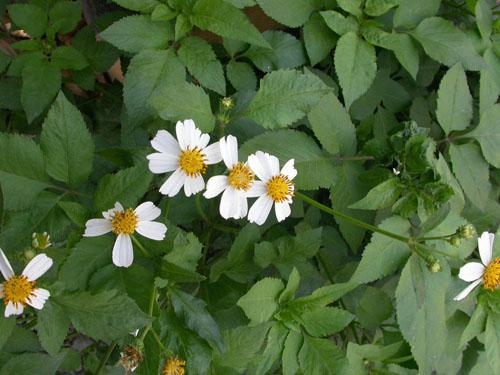Is Xianfeng grass a Bidens bipinosa? what kind of plant is it? What is the specific effect of Xianfeng herbal medicine value
Xianfeng grass and Bidens bipinosa many people will admit mistakes, or regard them as a plant, in fact, it is not, these are two kinds of plants. Xianfeng grass can be seen everywhere, which belongs to the genus Asteraceae. In Taiwan, there are large flowers salty abundant grass, small flowers salty abundant grass and ghost needle grass. Among the three species of Xianfeng grass, only Bidens bipinnata is native species, and the first two species are exotic species. It is worth noting that the big flower salty grass is a perennial herb (small flower salty rich grass and Bidens bipinnata is annual), which blossoms all the year round, unlike other annual plants that have a season of death.
Xianfeng grass, coupled with flowers mostly honey and barb thorn fruit, has become the most dominant Xianfeng grass, and even affects the whole environment and ecology. Herb juice, which is often used to relieve summer heat and reduce fire in Taiwan, has the effects of clearing heat, detoxification, diuresis, dispersing blood stasis, and can treat gastrointestinal diseases and bacterial infections.
It is pointed out that there are many plant secondary metabolites with different chemical structures in Xianfeng grass, including flavonoids, phenylpropionic acids, polyacetylene and so on. It is worth noting that the methanol extract and polyacetylene of Xianfeng grass have hypoglycemic activity in the model of type 2 diabetic mice.
The active substances in Xianfeng grass were separated by high performance liquid chromatography. It was found that Xianfeng grass extract and its polyacetylene could effectively prevent the occurrence of type 1 diabetes in the animal model of non-obese mice. This suggests that Xianfeng grass extract and its polyacetylene may be effective in the treatment of type 1 diabetes, mainly by regulating the differentiation of lymphoid cells (a kind of lymphoid cells produced by the thymus). To ease the attack of the immune system on islet cells, thus indirectly protecting islet cells. In addition, the researchers also found that Xianfeng grass has a hypoglycemic effect, but its mechanism is still under study.
The above studies on the modernization of herbs have led to a scientific interpretation of Xianfeng grass, which is often used in the treatment of diabetes, but there are still many questions worthy of in-depth study, such as through what mechanism does Xianfeng grass achieve the hypoglycemic effect? This is an important research direction. In addition, although Xianfeng grass is considered edible by the United Nations Food and Agriculture Organization and the Department of Health of China, the safe dose and side effects still need to be clarified. These research results may not only make Xianfeng grass have the opportunity to become a healthy food or plant medicine on the market, but also provide substantial help to the establishment of the modernization of Chinese herbal medicine.

- Prev

The occurrence of rust in pineapple and Sakya orchards, what are the symptoms and characteristics of rust? what are the prevention and control methods?
Due to the heavy moisture in orchards such as mountain areas and river valleys, it is easy to cause the spread and spread of "Annona rust". The Agricultural improvement Farm of Taitung District of the Council of Agriculture (hereinafter referred to as Taitung Field) recently monitored Peinan, Luye and Donghe and found that there have been some pineapple Sakyamuni fruits.
- Next

Anthracnose, the main disease of papaya fruit, what causes anthracnose and how to control it?
Papaya (Carica papaya) is an attractive tree with large green berries ripe yellow or orange because of its tropical appearance and delicious edible fruit. Some people call this tree and fruit papaya. When you see the sunken spots on those papaya fruits, you
Related
- A course of planting techniques and methods on how to grow carrots
- How to plant the latest tulips?
- Is it better to pick tea in the morning or in the afternoon? When is the best time for tea to be picked? what is the third or fifth tea?
- Launch Yuanxiao Happy combination Haocha + Tea Yuan healthy Taste
- Penghu Tourism "Fireworks 20 Parade with You"
- 2022 West Lake Happiness holds "Digital Revitalization Voucher" and draws iphone13 and laptop.
- Banqiao Fuzhou social houses are designed to change start-up combined with police elimination to create a safe and livable environment
- The convenient measure of "mechanical weeding" in Xinbei has been abused and the Agriculture Bureau has imposed heavy penalties on the illegal land consolidation.
- Changgeng University Joins Hands with Four Memory Factories to Rescue Memory Talent Shortage
- The list of Taiwan's top 100 MVP managers is listed by the Director-General of the Farmers' Association of Sanxia District.

